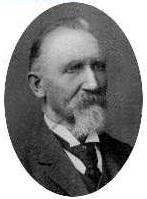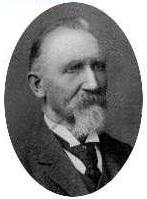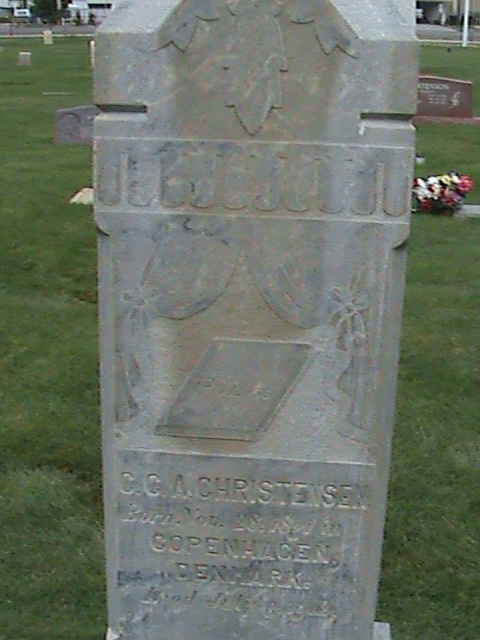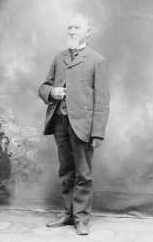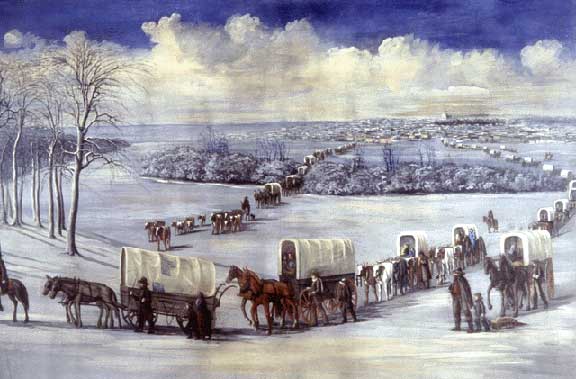Married Eliza Rosalia Sternhjem Scheel, 24 Apr 1857, Liverpool, Lancaster, England
Married Maren Frederikke Pettersen, 30 Nov 1868, Salt Lake City, Salt Lake, Utah
Carl C. A. Christensen was the oldest of four sons. Although his family had owned an inn, they had suffered such severe financial reverses that they were reduced to poverty about the time Carl was born. Discouragement and poverty caused Carl's father to drink. This did not make things any easier for the patient, hardworking Dorothea and her four sons. Dorothea did her best to provide for her children by hiring out to do washing and other household tasks. Carl cared for the younger children, and took the baby to the mother to be nursed at feeding times.
Later in life, C.C.A. wrote: "When my mother was home, she cared for us with all the love and strength of a good, devoted mother... and she planted in our young hearts a noble seed for good, which never fully was destroyed."
When he was young, he wrote, he had to clean the house, which he did "as well as I could, and I can say that I put forth an effort, so that everything should be all right when my mother came home in the evening.
"Mother was gifted in cutting out birds, animals, and persons with surprising accuracy, and it was in this way that she entertained her children in the absence of any toys. She taught me to use the scissors and make things as could be used for toys by me and my brothers. I soon learned to draw with a sure hand. I always tried to imitate very correctly the profile of everything I saw, and was admired quite a bit by everyone who watched me."
Carl learned to read and write from his mother, and at an early age showed special talent as a writer as well as an artist.
The care of her children pressed heavily upon Carl's mother, and in her deeply based religious nature, she turned in prayer to God. She had a wonderful dream that some high-standing person would sometime in the future make her and her children very happy. Upon this promise she built up a hope and faith in the future. Concerned about her sons development, she again was prompted in a dream to make application for her griped child to enter the state school for the worthy poor. Young Carl took the examination and did well, for despite his being the youngest in his public school class, he had been number one for a year and a half.
The institution of benevolence was a new experience for eleven-year-old Carl. He could visit his family only on holidays—if his behavior was good. The boys, who slept in large dormitories, were assigned a number (he was 59), and each was called by that number.
At the age of fourteen he was confirmed in the Lutheran Church, according to the custom of his native land, and a week later, upon leaving the state school, he was apprenticed to a carpenter, in a manual training school. It was while attending the manual training school that Carl's ability to cut silhouettes turned to his advantage. It happened that the widow of an Admiral Bruun, a sea hero of Denmark and a friend of Miss Eiea-nore Harbo, herself a painter and artist who had studied art under the best teachers in Copenhagen and Paris, became interested in Carl's welfare, and through their influence he was accepted to study in the King's Royal Academy of Arts.
He was able to begin his training in carpentry and studied art in the evenings of the six winter months. He remained at the King's Royal Academy of Arts for six or seven years, associating with renowned artists and surrounded by art work. To become an artist became his ideal. He was tied to his carpentry work for seven years, by contract, but through the influence of Miss Harbo and the other interested ladies, as well as the authorities of the Academy, Carl was released from his carpentry contract.
He now began his new life as a painter. His new master, Carl Rosent, gave him the opportunity to achieve in the art of painting. He also taught him the practical art of house painting and decorating. He should have remained in this school for five years, but before this time was up, there happened the most important event in his life.
In 1850, Elder Erastus Snow, with three other elders, came to Copenhagen to open up a mission in the Scandinavian countries. Carl's mother heard the message of these elders and was baptized into the Church. Carl soon became interested and was baptized September 26, 1850. His three brothers also joined the Church, but his father would have nothing to do with Mormonism.
When it became known at the Academy that Carl had become a Mormon, he was immediately ostracized by his friends and school associates. He suffered much persecution, which, because of his sensitive nature, gave him much pain. Because of his interest in his new religion, he dropped his desire of becoming an artist, but he still continued his studies at the Academy until January 1853, when he graduated with high honors from the King's Royal Academy of Fine Arts.
Just after his graduation, he was ordained a priest and sent out as a missionary to West Sjolland. This was the beginning of several years of missionary service. In October of 1853, he bade good-bye to his mother and three brothers, who were sailing for America. Carl did not know that he would never see his mother again in this life. She died in Salt Lake City in September, 1855.
His first mission was marked by the typical experiences suffered by many other missionaries as they tried to introduce the restored gospel to new lands. He was imprisoned several times for preaching and was twice sentenced to five days of bread and water. He was a spokesman for the Church in public debates in the Norwegian capital where, as a result of his impressive preaching and engaging personality, several persons of civic prominence became friendly to the Mormons. In the winter of 1855, he trudged 165 miles over ice and snow, pulling a small sleigh with his belongings, to reach Saints in an outlying area. That same year he was appointed president of the Norwegian Conference, which included all of Norway.
During this time, Carl's art was practically forgotten. His art of house painting occasionally was put to use to earn some money to help to pay a fine for a brother missionary (held on charge of preaching) or to provide sustenance for himself and his companions.
It was during this time of missionary service that Carl's other talents gained magnitude. This was when his best poems and songs were written. There is a complete volume of writings by C.C.A. Christensen. Unfortunately, his writings were all in the Danish or Norwegian language, and thus are not enjoyed by his posterity. However, they are sources of comfort, joy, and hope to the Scandinavian countries.
C.C.A. wanted to emigrate to Utah to be with the general body of the Church, and so, in company with other European Latter-day Saints, he sailed to England. On April 24, 1857, before boarding the ship at Liverpool, he married one of the first woman converts in Norway, Eliza Rosalie Van Schel.
He was a steward over the Scandinavian Saints while crossing the sea and was division captain with the handcart group with which he and his bride walked the distance of 1,300 miles. They arrived in Salt Lake City on September 13, 1857, practically penniless but with faith in God and hope for better days.
Their first years in Utah were much like those of other pioneers. Despite the Indian wars, grasshopper plagues, snakes, droughts, and other hardships, he helped found the town of Mt. Pleasant. Although his vocation and training were for printing, writing, and art, he worked at whatever labor was available. He was mason's helper, printer's helper, and even tried his hand at farming. Later he worked as scene painter for the Salt Lake Theatre.
On a Sunday morning in 1865, thirty-three-year-old Carl received a letter from Brigham Young calling him to a second mission to Norway. His experiences in making financial preparations for this mission are humorous, sometimes pathetic, but faith inspiring. He called his little family together and gave a father's blessing to each of his three children, all under six years of age. He again presided over the Norwegian Conference, which included about one hundred Saints. (Sadly, he arrived in Europe just one year after the death of his father.)
While in Norway in 1866, he turned to portrait painting to help support himself, and succeeded beyond all expectations. With the permission of the mission president he was also able to take lessons from Philip Barlag, a very accomplished young man. in May 1866, Carl was released from this mission and he arrived home safe and well in July, in company with a large group of immigrants who had left Liverpool in June.
On November 30, 1868, he married Maren Frederikka Patterson. Shortly after his mission he was called to preside over the 47th Quorum of Seventies, which position he held for thirty years.
C.C.A. took his family to Ephraim, and a year later moved to Fairview where they resided briefly until Indian trouble forced them to return to Ephraim.
He did much Scene painting in the Manti and St. George temples, establishing a well-known name in the community and among fellow Scandinavians for his artistic and literary abilities.
The family recalls that C.C.A. often mixed his own pigments, sometimes from the herbs and plants growing wild in his community. His children remembered riding with him in the buggy to other towns, seeking witnesses to the scenes of Church history that he was painting. After sketching in an event, he would ask those who would assist to help him fill in the details a bush here, some children there, the hill sloping just so. It was his desire to make his pictures accurate, and he sought information firsthand from as many witnesses as possible.
He painted a panorama of Bible and Book of Mormon scenes which has been lost. The second panorama on Church history was apparently commenced by the mid-1870s. It was called the Mormon Panorama. In 1882, while his son was on a mission, he received permission from the First Presidency to exhibit the panorama between Salt Lake and Ogden to earn money for his son's mission.
In 1887, he was called back to Copenhagen on a third mission, where he served until 1889; his responsibilities were to write, translate, and serve as general manager of the bimonthly Church publication.
The following year he traveled throughout the state showing his famous Mormon Panorama, which was of great interest to people everywhere.
During the 1890s he continued his interest in painting and writing. He freely gave encouragement and uplift to all who knew him, and he was universally admired and loved for his talents, personality, and character. As an indication of his spiritual strength, in 1900 he was ordained as South Sanpete Stake patriarch.
He spent the last eleven years of his life as a staff member in the Church Historian's Office. Here he served as writer, translator, and compiler of material on the history of the Scandinavian Saints and the Scandinavian mission, much of his work serving as the basis for the official Church history of these people. When his love of art and writing and his love of the gospel could all be given expression in the same portrayal, he realized some of his happiest hours.
Carl Christian Anton Christensen died at the age of eighty.
Married Eliza Rosalia Sternhjem Scheel, 24 Apr 1857, Liverpool, Lancaster, England
Married Maren Frederikke Pettersen, 30 Nov 1868, Salt Lake City, Salt Lake, Utah
Carl C. A. Christensen was the oldest of four sons. Although his family had owned an inn, they had suffered such severe financial reverses that they were reduced to poverty about the time Carl was born. Discouragement and poverty caused Carl's father to drink. This did not make things any easier for the patient, hardworking Dorothea and her four sons. Dorothea did her best to provide for her children by hiring out to do washing and other household tasks. Carl cared for the younger children, and took the baby to the mother to be nursed at feeding times.
Later in life, C.C.A. wrote: "When my mother was home, she cared for us with all the love and strength of a good, devoted mother... and she planted in our young hearts a noble seed for good, which never fully was destroyed."
When he was young, he wrote, he had to clean the house, which he did "as well as I could, and I can say that I put forth an effort, so that everything should be all right when my mother came home in the evening.
"Mother was gifted in cutting out birds, animals, and persons with surprising accuracy, and it was in this way that she entertained her children in the absence of any toys. She taught me to use the scissors and make things as could be used for toys by me and my brothers. I soon learned to draw with a sure hand. I always tried to imitate very correctly the profile of everything I saw, and was admired quite a bit by everyone who watched me."
Carl learned to read and write from his mother, and at an early age showed special talent as a writer as well as an artist.
The care of her children pressed heavily upon Carl's mother, and in her deeply based religious nature, she turned in prayer to God. She had a wonderful dream that some high-standing person would sometime in the future make her and her children very happy. Upon this promise she built up a hope and faith in the future. Concerned about her sons development, she again was prompted in a dream to make application for her griped child to enter the state school for the worthy poor. Young Carl took the examination and did well, for despite his being the youngest in his public school class, he had been number one for a year and a half.
The institution of benevolence was a new experience for eleven-year-old Carl. He could visit his family only on holidays—if his behavior was good. The boys, who slept in large dormitories, were assigned a number (he was 59), and each was called by that number.
At the age of fourteen he was confirmed in the Lutheran Church, according to the custom of his native land, and a week later, upon leaving the state school, he was apprenticed to a carpenter, in a manual training school. It was while attending the manual training school that Carl's ability to cut silhouettes turned to his advantage. It happened that the widow of an Admiral Bruun, a sea hero of Denmark and a friend of Miss Eiea-nore Harbo, herself a painter and artist who had studied art under the best teachers in Copenhagen and Paris, became interested in Carl's welfare, and through their influence he was accepted to study in the King's Royal Academy of Arts.
He was able to begin his training in carpentry and studied art in the evenings of the six winter months. He remained at the King's Royal Academy of Arts for six or seven years, associating with renowned artists and surrounded by art work. To become an artist became his ideal. He was tied to his carpentry work for seven years, by contract, but through the influence of Miss Harbo and the other interested ladies, as well as the authorities of the Academy, Carl was released from his carpentry contract.
He now began his new life as a painter. His new master, Carl Rosent, gave him the opportunity to achieve in the art of painting. He also taught him the practical art of house painting and decorating. He should have remained in this school for five years, but before this time was up, there happened the most important event in his life.
In 1850, Elder Erastus Snow, with three other elders, came to Copenhagen to open up a mission in the Scandinavian countries. Carl's mother heard the message of these elders and was baptized into the Church. Carl soon became interested and was baptized September 26, 1850. His three brothers also joined the Church, but his father would have nothing to do with Mormonism.
When it became known at the Academy that Carl had become a Mormon, he was immediately ostracized by his friends and school associates. He suffered much persecution, which, because of his sensitive nature, gave him much pain. Because of his interest in his new religion, he dropped his desire of becoming an artist, but he still continued his studies at the Academy until January 1853, when he graduated with high honors from the King's Royal Academy of Fine Arts.
Just after his graduation, he was ordained a priest and sent out as a missionary to West Sjolland. This was the beginning of several years of missionary service. In October of 1853, he bade good-bye to his mother and three brothers, who were sailing for America. Carl did not know that he would never see his mother again in this life. She died in Salt Lake City in September, 1855.
His first mission was marked by the typical experiences suffered by many other missionaries as they tried to introduce the restored gospel to new lands. He was imprisoned several times for preaching and was twice sentenced to five days of bread and water. He was a spokesman for the Church in public debates in the Norwegian capital where, as a result of his impressive preaching and engaging personality, several persons of civic prominence became friendly to the Mormons. In the winter of 1855, he trudged 165 miles over ice and snow, pulling a small sleigh with his belongings, to reach Saints in an outlying area. That same year he was appointed president of the Norwegian Conference, which included all of Norway.
During this time, Carl's art was practically forgotten. His art of house painting occasionally was put to use to earn some money to help to pay a fine for a brother missionary (held on charge of preaching) or to provide sustenance for himself and his companions.
It was during this time of missionary service that Carl's other talents gained magnitude. This was when his best poems and songs were written. There is a complete volume of writings by C.C.A. Christensen. Unfortunately, his writings were all in the Danish or Norwegian language, and thus are not enjoyed by his posterity. However, they are sources of comfort, joy, and hope to the Scandinavian countries.
C.C.A. wanted to emigrate to Utah to be with the general body of the Church, and so, in company with other European Latter-day Saints, he sailed to England. On April 24, 1857, before boarding the ship at Liverpool, he married one of the first woman converts in Norway, Eliza Rosalie Van Schel.
He was a steward over the Scandinavian Saints while crossing the sea and was division captain with the handcart group with which he and his bride walked the distance of 1,300 miles. They arrived in Salt Lake City on September 13, 1857, practically penniless but with faith in God and hope for better days.
Their first years in Utah were much like those of other pioneers. Despite the Indian wars, grasshopper plagues, snakes, droughts, and other hardships, he helped found the town of Mt. Pleasant. Although his vocation and training were for printing, writing, and art, he worked at whatever labor was available. He was mason's helper, printer's helper, and even tried his hand at farming. Later he worked as scene painter for the Salt Lake Theatre.
On a Sunday morning in 1865, thirty-three-year-old Carl received a letter from Brigham Young calling him to a second mission to Norway. His experiences in making financial preparations for this mission are humorous, sometimes pathetic, but faith inspiring. He called his little family together and gave a father's blessing to each of his three children, all under six years of age. He again presided over the Norwegian Conference, which included about one hundred Saints. (Sadly, he arrived in Europe just one year after the death of his father.)
While in Norway in 1866, he turned to portrait painting to help support himself, and succeeded beyond all expectations. With the permission of the mission president he was also able to take lessons from Philip Barlag, a very accomplished young man. in May 1866, Carl was released from this mission and he arrived home safe and well in July, in company with a large group of immigrants who had left Liverpool in June.
On November 30, 1868, he married Maren Frederikka Patterson. Shortly after his mission he was called to preside over the 47th Quorum of Seventies, which position he held for thirty years.
C.C.A. took his family to Ephraim, and a year later moved to Fairview where they resided briefly until Indian trouble forced them to return to Ephraim.
He did much Scene painting in the Manti and St. George temples, establishing a well-known name in the community and among fellow Scandinavians for his artistic and literary abilities.
The family recalls that C.C.A. often mixed his own pigments, sometimes from the herbs and plants growing wild in his community. His children remembered riding with him in the buggy to other towns, seeking witnesses to the scenes of Church history that he was painting. After sketching in an event, he would ask those who would assist to help him fill in the details a bush here, some children there, the hill sloping just so. It was his desire to make his pictures accurate, and he sought information firsthand from as many witnesses as possible.
He painted a panorama of Bible and Book of Mormon scenes which has been lost. The second panorama on Church history was apparently commenced by the mid-1870s. It was called the Mormon Panorama. In 1882, while his son was on a mission, he received permission from the First Presidency to exhibit the panorama between Salt Lake and Ogden to earn money for his son's mission.
In 1887, he was called back to Copenhagen on a third mission, where he served until 1889; his responsibilities were to write, translate, and serve as general manager of the bimonthly Church publication.
The following year he traveled throughout the state showing his famous Mormon Panorama, which was of great interest to people everywhere.
During the 1890s he continued his interest in painting and writing. He freely gave encouragement and uplift to all who knew him, and he was universally admired and loved for his talents, personality, and character. As an indication of his spiritual strength, in 1900 he was ordained as South Sanpete Stake patriarch.
He spent the last eleven years of his life as a staff member in the Church Historian's Office. Here he served as writer, translator, and compiler of material on the history of the Scandinavian Saints and the Scandinavian mission, much of his work serving as the basis for the official Church history of these people. When his love of art and writing and his love of the gospel could all be given expression in the same portrayal, he realized some of his happiest hours.
Carl Christian Anton Christensen died at the age of eighty.
Family Members
-
![]()
Eliza Virginia Christensen Olson
1859–1925
-
![]()
Charles John Christensen
1861–1928
-
![]()
Fredrick William Christensen
1863–1912
-
![]()
Diantha Andrea "Dorothea" Christensen Christensen
1865–1928
-
![]()
Mary Ann Jensen Christensen Welling
1870–1953
-
![]()
Julia Eleanora Christensen Nielson
1871–1899
-
Canute Ephraim Christensen
1872–1929
-
![]()
Teckla Pauline Christensen Nielson
1874–1935
-
![]()
John Carlos Christensen
1875–1943
-
![]()
Parley B Christensen
1877–1918
-
![]()
Hyrum Moroni Christensen
1882–1946
Sponsored by Ancestry
Advertisement
Advertisement
